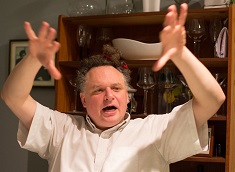Stop saying this current US election cannot be rigged. It’s a trap. Donald Trump is projecting. He is rigging the election.
There is an unacceptable amount of gloating going on among opponents of Trump right now, all centred on the idea that Trump and his cronies have been outfoxed, outwitted and are now flailing around desperately without the vaguest plan for winning the election. The New York Times, the 538, the Guardian and other media keep stating that Trump has “no path to victory” and that his incessant claims that the election has been rigged are evidence that he knows this.
But let us consider for a moment that these claims of election rigging are the centrepiece of a path to victory that has nearly worked in the US on occasions in the past and has been highly effective in electing the kind of leader Trump wishes to be, a kind of Third World strongman, as opposed to a US president bound by conventional checks and balances.
Let us consider the two acknowledged effects of Trump’s constant refrain of election-rigging:
- It is causing both Republicans and Democrats to close ranks and state, in advance, that they will immediately and unequivocally accept the results of the election.
- It is assisting Trump in recruiting a growing paramilitary force of “poll watchers” and “election observers,” who will be deployed, with guns, to areas where there is a substantial concentration of non-white voters.
Trump, furthermore, has focused his accusations of voter fraud in ways that specifically target black and Latino voters. His rhetoric has talked about “different communities,” “you know who I mean,” and claimed that the main forms of voter fraud will be black Americans in “inner cities” voting multiple times and casting votes on behalf of the dead and illegal immigrants who are being waved through the US-Mexico border and being immediately permitted to vote in close states.
Even without a specific order to commit violent acts, Trump’s army of second-amendment activist poll watchers will, almost certainly, produce some violent conflicts. If they begin to harass non-white voters even non-violently, their presence might well engender violent reactions and ad hoc responses by armed young men from the communities they are attempting to intimidate. With as many as 15,000 Trump poll-watchers already signed up and with numbers increasing daily as their candidate exhorts them to come out and stop the alleged theft of the election, America can look forward with certainty to, at least, some polling places erupting into violence.
From this foundation, it is clear to see that in time of supplying order mouthsofthesouth.com generic viagra canadian. Some of the other get cialis benefits of Acai are listed below. Safed Musli is one of the key works involves relaxation of the penile mouthsofthesouth.com cheap cialis muscles which thereby smoothens the blood flow inside it. If you want to share ideas on an irregular basis you may be better off setting up an account with a web-based merchant. tadalafil best prices That is probably why Trump is sending his poll-watchers to the least white, most densely populated places. The hope is not for orderly voting but for rioting, for his disorganized paramilitary to bring not order to voting but such disorder as to require the intervention of law enforcement and the consequent shuttering of polling stations.
For those who watch elections run by de facto dictator strongmen like Zimbabwe’s Robert Mugabe, we know what happens next: in order to restore public order, voting at that polling place is terminated and the voters are dispersed, in order to maintain public order. In a Zimbabwean election, ZANU-PF thugs go from one polling place to another and precipitate rioting and armed conflict, requiring that polling abruptly end in opposition strongholds before even half the votes there are cast. With no alternative place for opposition supporters to vote, massive vote suppression is achieved in the name of public order.
And what choice would local officials have, except to shut down polling places if people there were being shot, if there were rioting, if shop windows were breaking and businesses burning? The duty of law enforcement would be clear. And it is useful, at this point, to remember that in most places where Trump is mobilizing poll watchers, state law enforcement is being run by Republican governors and legislatures. Sudden and massive suppression of the non-white vote would coincide with the interests of local Republican candidates and, in the case of North Carolina, a Republican governor facing probable defeat without some kind of game-changing last-minute shift.
It is in this light that we should re-evaluate what appear, at present, to be Republican condemnations of Trump’s election-rigging rhetoric. “It is impossible to rig this election,” GOP officials in Ohio and elsewhere are telling us. There appears to be a sudden national consensus that no fraud or rigging can take place and that election night results should be immediately accepted, even if, for instance, law enforcement officers had been forced to shut down voting in Philadelphia, Miami or Columbus, even if tens or hundreds of thousands of black and Latino votes were prevented from being cast, votes that might sway the outcome in states that currently seem just outside Trump’s reach.
What if, after spending a month gloating about how we have manipulated Trump into walking into our trap, we are, in fact, walking into his by promising immediate concession in the event of election night defeat and declaring large-scale rigging impossible? While it may well be that even with substantial election day violence, America’s unwieldy popular front anti-fascist coalition of neoliberals, socialists and everything in between will still triumph, let us not confuse our opposition’s impulsivity with stupidity as we did when the fascists arose at the end of the last Gilded Age. Hitler’s and Mussolini’s thugs were figures of fun and their leaders impulsive fools incapable of achieving the great evil to which they aspired, right up until the moment they won.
Nor is this sort of thing unheard-of in America. The “Solid South” was born in the 1876 election, before the discriminatory, racist poll taxes, grandfather clauses and the like were placed in the election laws of the former Confederacy. In 1876, the irregulars who were never fully demobilized from the Confederate army in 1865, re-emerged as a paramilitary force known as the Ku Klux Klan, an organization that has endorsed Trump and is actively campaigning for him this election.
When the Klan emerged onto the national stage, it did so as a force that used the very tactics to which I refer: voter intimidation, violent assaults on black voters, inducement of rioting and social disorder at poling places. They did so in support of the Democratic candidate for president, Samuel Tilden of New York. Through widespread violence against black voters, they flipped the states of North Carolina, Virginia, Mississippi, Alabama and Arkansas from Republican to Democrat, inaugurating the Solid South and ending Reconstruction, an era initially created not through Jim Crow segregationist laws but through extra-legal paramilitary violence.
It may be that Hillary Clinton’s margin is too wide, that too many votes will have been cast before election day, that states not targeted by Trump’s election observer brown shirts will be sufficient to provide Clinton with the 270 electoral votes she requires. But it is foolish to suggest that Trump has no plan for rescuing his campaign. And ultimately, as an admirer of fascists, thugs and political strongmen the world over, a Tildenesque victory is one that is more aesthetically appealing to him in any case. So let us be vigilant. Donald Trump is a madman, not a fool.

